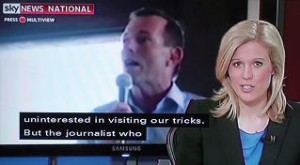Media Accessibility: Bringing down the wall
 Australia’s biggest cinema chains recently signed a deal to provide more accessible screens, and more free-to-air and pay TV content is being captioned than ever before. But is this enough to guarantee equal media access to all Australians? Georgina Pearson reports.
Australia’s biggest cinema chains recently signed a deal to provide more accessible screens, and more free-to-air and pay TV content is being captioned than ever before. But is this enough to guarantee equal media access to all Australians? Georgina Pearson reports.
As the population of Australia continues to age, the need for media accessibility services is becoming increasingly apparent. According to the Australian Bureau of statistics, 1 in 6 Australians are deaf or hearing impaired (a number expected to increase to 1 in 4 by 2050), and there are currently over 300,000 Australians living with blindness or vision impairment (expected to increase to 600,000 by 2020).
This seemingly rapid forecast has sparked a huge push in the availability of media accessibility services such as captioning – the audio track displayed as text on-screen – and audio description (AD) – a verbal description of what is happening on screen.
These services are currently available at a limited number of cinemas, but after an agreement was reached earlier this year, the country’s four biggest cinema chains (Hoyts, Greater Union, Village and Reading) have committed to providing captions and audio descriptions on at least one screen in all of their complexes by the end of 2014 (roughly one accessible cinema screen to every 149,000 people). The financing of the rollout will be fronted by the cinemas themselves with 20 percent of the total cost put up by the government.


Hi Georgina,
An excellent and timely article.
Whist progress is being made on several fronts (due mainly to the efforts of groups like Deafness Forum and Media Access), can I please ask you to do one thing?……
Please spend one evening watching television (especially news and current affairs programs), WITH THE SOUND TURNED OFF AND THE CAPTIONS ON !!
You’ll quickly see how far we have yet to go in accessing good quality captions and achieving the same access as hearing people.
Thanks so much.
Lyn Beaumont
Hi Lyn,
Thanks very much for your feedback- i appreciate it. And i will most certainly try your suggestion!
Georgina Pearson
Hi
Great article. Being Deaf myself I am excited that things are moving forward and more and more content is being captioned. I would have to disagree with Lyn regarding quality of captions. Whilst i find sometimes there is a delay on live TV, I have never really had a problem with quality. From my understanding it is not a simple process delivering captions to our tv sets, and am just so thankful to those people that work so hard to deliver these captions every day of the year.
Whilst I would love to see 100% of all TV channels captioned, I honestly believe the issue isnt the quality but more so the amount of content available to us.
Rick
The only problem with captioning quality I’ve seen is with the ABC over the past few years. The captioning, especially on the evening news has really gone downhill compared to a few years ago. The result of cost-cutting, maybe? The ABC would do well to look at the commercial networks, who definitely seem to have their act together in this regard. Echoing Rick Greeward’s comment, I’d definitely like to see more things captioned, especially movies. It’s great that the big chains are committing to captioning, let’s just hope they follow through.